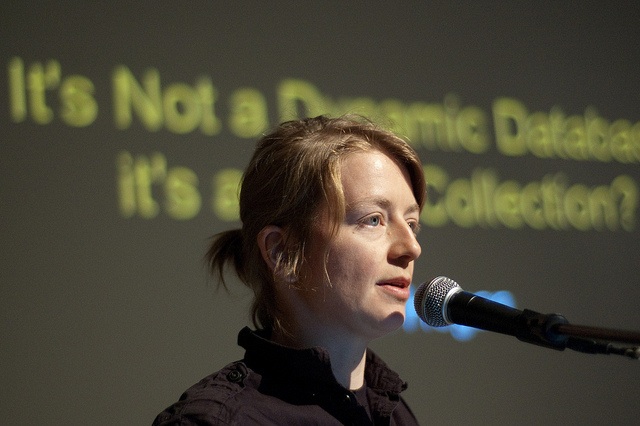By Geert Faber
The second day of the Video Vortex conference started with the session ‘It’s not a dead collection, it’s a dynamic database’ covering a next phase of digitalizing and distributing video archives. The first presentation of the day is from Mél Hogan who talks about the rise and fall of three large online video art repositories in Canada and the setbacks they encountered. Mél Hogan is currently completing her research creation doctorate in Communication Studies at Concordia University in Montréal, Canada. Her research documents defunct, stalled, and crashed online video art repositories within a Canadian cultural context.
The title of her presentations (and of this blog) provokes the title of the session and questions whether the web provides a dynamic databases or dead collections. The growth of YouTube and its popularity has set new standards for online video databases, archives, and interfaces. More often online projects become entities on themselves instead of just bringing an offline collection online.
To showcase the difficulties of bringing video art repositories online, Mél discusses three cases from Canada and the setbacks they encountered. These cases were created by interviewing the people, partners, and organizations involved, by reviewing ground reports, and tracking the visual history of these collections and website by using the Internet Archive Wayback Machine. A general notion among these online projects is the implied value of the content the archives contain and the focus on the broader context. All the project envisioned an archive of videos and described a context in which those videos should be placed, however, the cases show that this context is often harder to develop and control, and affects the popularity and success of the online archives.
The first case describes the start of Vidéographe by viThèque which started in 2010 and is still online. The project encountered several setbacks in the development of the channel because of the involvement of several different partners and getting copyrights for the content. After years of development the project is now taken into the courtroom to settle arguments between different ex-partners, resulting in a widespread of competitive online channels presenting the video material of Vidéographe. A showcase how context is hard to manage and control on the web, and how the offline organization of projects can influence this.
The second case discusses the Vtape project which started in 2006 and ended in 2008 being a part of the virtual museum of Canada (Musée virtuel du Canada). The website has an active link to the archive but has been offline, or ‘temporarily unavailable’, for many years now, questioning the access of websites beyond the technical framework.
The last case discussed the Médiathèque project initiated by SAW video’s which started in 2003 and ended in 2009. The website provided artists a payment of 200 dollar per year for every submitted video. The website turned out to be an online repository of online video which focused more on availability instead of context, a faith, as Mél notes, for all digital media. A severe server crash in 2009 suddenly ended the availability of the website and it has been offline ever since. Although back-ups are available the website is still offline as a result of lack of dedication from SAW video’s, and new initiatives being developed. Mél Hogan has written a more detailed overview of the rise and fall of Médiathèque and the traces left on the web in a paper for FlowTV.org.
Collaborations with different partners and receiving long-term funding are common difficulties for online art video repositories. It is still unclear who controls and owns the content in the databases and how copyright material should be distributed from these archives. The cases discussed shows how videos were dispersed over different video portals including popular video websites such as YouTube and Vimeo. Another setback many online repositories faced was the adoption by both the audience and the artists, over time hits declined and channels were never adopted by the video art community. A challenge new channels trying to tackle by including social media tools for reaching their audience. Having the technology in place is not enough, context, partners, relationships with artists, and funding has an important influence on the success of the channel. This can be achieve, for example, by developing a good connection between the artist and the platform and by giving the artist some control over the platform to involve them in the process to keep the platform online. However, as Mél notes, crashes and broken links have shown the paradoxical nature of online archives; failures are part of the narrative.
On Twitter: @Mél Hogan
About the author: Geert Faber graduated with a Master of Science degree in Business Administration from the Free University in Amsterdam and is currently graduating as a Bachelor of Arts in Media & Culture specializing in New Media and Television studies.
On Twitter: @GeertFaber




